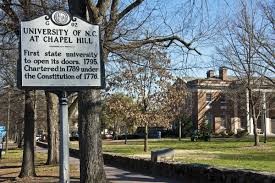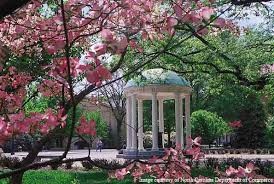Historical Marker-University of North Carolina at Chapel Hill
Introduction
Text-to-speech Audio
The University of North Carolina at Chapel Hill was established in 1789 and officially opened to students in 1795 as the first public university in the United States. The university is accredited by the Southern Association of Colleges and Schools Commission on Colleges and is a member of the Association of American Universities. Chapel Hill offers 78 baccalaureate, 112 master’s, 68 doctoral, and seven professional degree programs and is widely known as one of the leading public research universities in the nation. The university has a student population of approximately twenty-nine thousand, a faculty base of nearly thirty-seven hundred, and boasts over 292,000 alumni that live in more than 150 countries.
Images
University of North Carolina Historical Marker

The Old Well served as Chapel Hill's only water supply through much of the nineteenth century. The well's current shelter, a Greek Revival structure designed after the Temple of Love in the Gardens of Versailles, was completed in 1897.

Backstory and Context
Text-to-speech Audio
On December 11, 1789, state legislators in North Carolina passed an act establishing the University of North Carolina. The bill was introduced by William Richardson Davie, a former military officer in the American Revolution, who hoped to fulfill the promise of a state-sponsored university outlined in Article Forty-one of the state's 1776 constitution. Davie, with the support of others, shepherded the bill through the meeting and is commonly referred to as the father of the university. The resulting act reflected the contemporary belief that the survival of democracies depended upon the education of future leaders. "[I]n all well-regulated governments," the act read, "it is the indispensable duty of every Legislature to consult the happiness of a rising generation, and endeavor to fit them for an honorable discharge of the social duties of life, by paying the strictest attention to their education." Legislators also agreed that permanent and sustainable funding for the university would ensure that it best meet its goals.
University trustees moved forward with plans to develop the university and in 1792 selected Chapel Hill as the site of the new campus. Chapel Hill was particularly appealing to the trustees because the location was near the capital city, Raleigh, and far removed from the powerful political circles of eastern North Carolina. Writing of the site in 1793, Davie remarked: "This town being the only seat of learning immediately under the patronage of the public, possessing the advantages of a central situation, on some of the most public roads in the state, in a plentiful country and excelled by few places in the world either for beauty of situation or salubrity of air, promises with all moral certainty to be a place of growing and permanent importance." Davie officiated at the cornerstone ceremony of the campus's first building, now known as Old East, on October 12, 1793. Eight buildings, constructed between 1793 and 1860, still stand on the university's campus and are listed as national historic landmarks.
The university steadily grew and by 1858 boasted a student body of 456. However, enrollment plummeted to ninety-one students by September 1861 and the university was forced to close in February 1871. Kemp P. Battle, a lawyer and future president of UNC, played an integral role in securing funds to reopen the university. Classes resumed in September 1875 and by 1887 the university had developed a teacher training program and law school. Sallie Walker Stockard became the first female graduate of the university in 1890, earning a master's degree in history. The liberal arts defined the university curricula by the early twentieth century and the university achieved unprecedented growth. Today UNC-Chapel Hill is widely known as one of the nation's leading public research institutions.
Sources
"About UNC," University of North Carolina at Chapel Hill, accessed on August 18, 2016, http://www.unc.edu/about/
"Carolina: A National Leader in Research," UNC Research, accessed August 18, 2016, http://research.unc.edu/about/
"Construction of Old East," The Carolina Story: A Virtual Museum of University History, accessed August 18, 2016, https://museum.unc.edu/exhibits/show/davie/sketch1797
"The First Century of the First State University," Documenting the American South, accessed August 18, 2016, http://docsouth.unc.edu/unc/index.html
"Act Establishing the University of North Caroliana, 1789," North Carolina General Assembly, 1789, accessed August 18, 2016, http://docsouth.unc.edu/unc/unc01-08/unc01-08.html
"Carolina: A National Leader in Research," UNC Research, accessed August 18, 2016, http://research.unc.edu/about/
"Construction of Old East," The Carolina Story: A Virtual Museum of University History, accessed August 18, 2016, https://museum.unc.edu/exhibits/show/davie/sketch1797
"The First Century of the First State University," Documenting the American South, accessed August 18, 2016, http://docsouth.unc.edu/unc/index.html
"Act Establishing the University of North Caroliana, 1789," North Carolina General Assembly, 1789, accessed August 18, 2016, http://docsouth.unc.edu/unc/unc01-08/unc01-08.html
